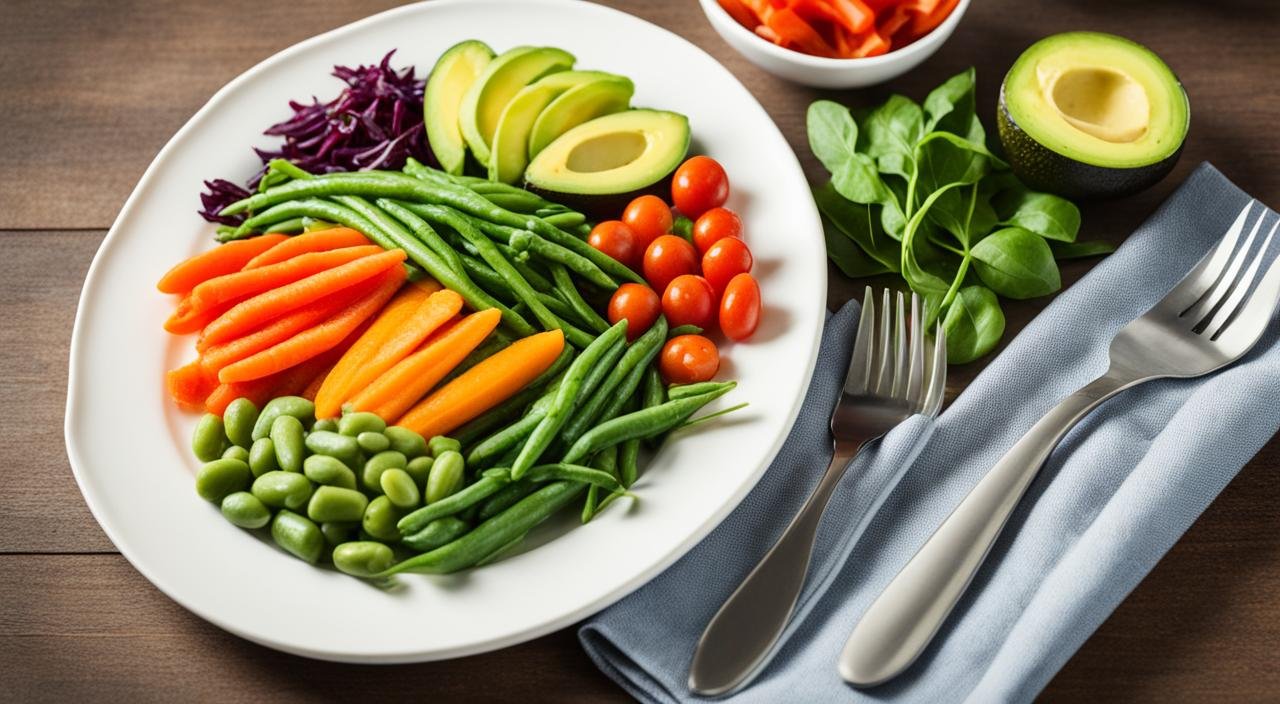Diabetes makes it hard for your body to control blood sugar levels. To manage diabetes, eating right is key. Knowing how foods affect your blood sugar is vital. This helps you make choices that keep your blood sugar in check.
Key Takeaways
- Diabetes is a condition where the body cannot produce or effectively use insulin, leading to high blood sugar levels.
- Proper nutrition is essential for managing diabetes and maintaining healthy blood sugar control.
- Focus on eating a variety of nutrient-dense foods that help regulate blood glucose, such as fruits, vegetables, whole grains, lean proteins, and low-fat dairy.
- Limit foods and drinks that can spike blood sugar, such as high-carbohydrate and sugary items, fried and high-fat foods, and alcohol.
- Incorporate carbohydrate counting and the plate method into your meal planning to help control portion sizes and balance your intake.
Understanding Diabetes and Blood Sugar Levels
Diabetes is a chronic condition that makes it hard for the body to control blood sugar levels. It happens when the body doesn’t make enough insulin or can’t use it well. This leads to too much glucose in the blood, causing high blood sugar levels.
What is Diabetes?
There are different types of diabetes, like type 1, type 2, and gestational diabetes. Type 1 is an autoimmune disorder where the body attacks insulin-producing cells. Type 2 is the most common, happening when the body doesn’t respond to insulin or doesn’t make enough of it. Gestational diabetes occurs during pregnancy and usually goes away after the baby is born.
How Do Foods Affect Blood Glucose Levels?
What we eat and drink affects our blood glucose levels. Carbs, for example, turn into glucose, raising blood sugar. People with diabetes need to watch their carb intake and choose foods that help keep blood glucose stable.
To keep blood sugar stable, a balanced diet is key. This includes:
- Fruits and vegetables
- Whole grains
- Lean proteins
- Low-fat dairy products
Knowing how diabetes and blood sugar levels are connected helps people make better diet and lifestyle choices. This way, they can manage their diabetes better.
Also Read :What Are The Types Of Stroke?
The Best Diet for Diabetes
Managing diabetes means finding the right diet. No single diet fits everyone, but some have proven effective. These include the DASH diet, the Mediterranean diet, the Flexitarian diet, and the Ornish diet.
These diets focus on whole, nutrient-rich foods like fruits, veggies, whole grains, lean proteins, and healthy fats. They also limit added sugars, refined carbs, and unhealthy fats. The goal is to pick a diet you can follow for a long time and that meets your health goals and likes.
| Diet | Overview | Benefits for Diabetes |
|---|---|---|
| DASH diet | Emphasizes fruits, vegetables, whole grains, lean proteins, and low-fat dairy, while limiting sodium, sweets, and red meat. | Helps lower blood pressure and improve insulin sensitivity, which are important for diabetes management. |
| Mediterranean diet | Focuses on plant-based foods like fruits, vegetables, whole grains, legumes, nuts, and olive oil, with moderate amounts of fish and poultry. | Reduces inflammation, improves cholesterol levels, and may help prevent type 2 diabetes and its complications. |
| Flexitarian diet | A flexible, plant-based eating plan that emphasizes fruits, vegetables, whole grains, and plant-based proteins, with occasional meat and dairy consumption. | Promotes weight loss, improves blood sugar control, and lowers the risk of chronic diseases like diabetes. |
| Ornish diet | A low-fat, plant-based diet that focuses on whole, unprocessed foods and limits the intake of animal products, oil, and refined carbohydrates. | Has been shown to reverse heart disease and may also improve insulin sensitivity and blood sugar management in people with diabetes. |
The best diabetes diet is one you can follow for a long time and that helps you reach your health goals. By eating a variety of nutrient-rich foods and avoiding added sugars and unhealthy fats, you can manage your blood sugar levels well. This can also lower the risk of diabetes-related problems.
Also Read :How Do I Reduce My Cancer Risk?
Foods to Eat if You Have Diabetes

Managing diabetes means choosing the right foods carefully. The foods you eat affect your blood sugar levels. Luckily, there are many foods that are good for diabetes. They help control blood sugar and give you important vitamins, minerals, and fiber.
Fruits and Vegetables
Fruits and vegetables are key for a diabetes-friendly diet. They are low in calories and carbs but high in fiber, vitamins, and minerals. Pick non-starchy veggies like leafy greens, bell peppers, broccoli, and tomatoes. Choose fruits that are lower on the glycemic index, such as berries, citrus fruits, and apples.
Whole Grains
Whole grains are great for managing blood sugar and giving you steady energy. Foods like quinoa, brown rice, oats, and whole wheat bread or pasta are good choices. They are high in fiber and digest slowly, which helps prevent sudden spikes in blood sugar.
Lean Proteins
Lean proteins like chicken, turkey, fish, and legumes are important for a balanced diet. They help you feel full and don’t cause big jumps in blood sugar. Stick to lean, non-fried proteins for the best diabetes management.
Low-Fat Dairy
Low-fat dairy products, including milk, yogurt, and cheese, are good for a diabetes-friendly diet. They offer protein, calcium, and other important nutrients without too many carbs. Go for low-fat or non-fat options to keep saturated fat intake low.
By eating these diabetes-friendly foods, you can make a diet that’s good for your health and helps control your blood sugar.
Also Read : How Does Coronavirus Impact Pets?
Foods to Limit for Blood Sugar Control

There are many diabetes-friendly foods to focus on. But, it’s key to watch out for foods and drinks that can raise blood sugar. These include high-carb foods, sugary foods, fried and high-fat foods, high-sodium foods, and alcohol.
High-Carb and Sugary Foods
Foods high in carbohydrates and added sugars can quickly raise blood sugar. Think white bread, pasta, rice, cereal, soda, candy, and baked goods. These should be eaten in small amounts if you have diabetes.
Fried and High-Fat Foods
Fried foods and high-fat foods are bad for diabetes. They can lead to weight gain and make it hard to control blood sugar. Foods like french fries, onion rings, and doughnuts, plus high-fat meats and full-fat dairy, should be eaten less often.
High-Sodium Foods
High-sodium foods are also a worry for people with diabetes. They can lead to high blood pressure, a common diabetes complication. Foods like processed meats, canned soups, and salty snacks should be cut down on.
Alcohol
Some people with diabetes can have a little alcohol, but it’s important to watch its effect on blood sugar control. Alcohol can lower blood sugar levels. Always talk to a healthcare provider about how to handle diabetes and alcohol safely.
Knowing which foods and drinks to limit helps people with diabetes manage their condition better. This keeps their blood sugar levels healthy.
Also Read :What Are The Types Of Business Insurance?
Meal Planning and Portion Control

Meal planning and controlling portions are key for people with diabetes. They help keep blood sugar stable. Carbohydrate counting and the plate method are two strategies that work well.
Carbohydrate Counting
Carbohydrate counting means tracking carbs in each meal and snack. This helps you see how foods affect your blood sugar. It lets you adjust your insulin doses better.
By keeping an eye on carbs, people with diabetes can better manage their health. They can make smart food choices.
The Plate Method
The plate method is a visual tool for portion control. It divides your plate into three parts: half for veggies, a quarter for protein, and a quarter for grains or starches. This way, you get the right nutrients and control carbs and calories.
| Plate Method Breakdown | Portion Sizes |
|---|---|
| Non-Starchy Vegetables | 1/2 plate |
| Lean Protein | 1/4 plate |
| Whole Grains or Starchy Foods | 1/4 plate |
Using these strategies, people with diabetes can better manage their health. They can keep blood sugar stable and support their overall health.
Also Read :What Are The Benefits Of Pet Insurance?
Diabetes and Physical Activity

Regular physical activity is key for managing diabetes. It helps lower blood sugar, makes insulin work better, and aids in weight control. These are vital for keeping diabetes under control.
The American Diabetes Association suggests at least 150 minutes of moderate-intensity aerobic activity each week. This can be brisk walking, swimming, or cycling. Adding 2-3 strength training and balance/flexibility sessions a week also brings more benefits.
It’s crucial to talk with your healthcare provider to find the best exercise plan for you. A balanced exercise routine helps you manage your diabetes and boost your health.
| Type of Exercise | Recommended Frequency | Benefits |
|---|---|---|
| Aerobic Activity | At least 150 minutes per week | Lowers blood sugar levels, improves insulin sensitivity |
| Strength Training | 2-3 sessions per week | Builds muscle mass, helps with weight management |
| Balance and Flexibility | 2-3 sessions per week | Improves balance, reduces risk of falls |
For successful diabetes management, combine a healthy diet, regular exercise, and teamwork with your healthcare providers. Living an active life lets you take charge of your diabetes and aim for a healthier future.
Maintaining a Healthy Weight with Diabetes

Keeping a healthy weight is key for managing diabetes and lowering the risk of complications. Being overweight, especially around the belly, can make it harder to control blood sugar. A mix of a healthy diet and regular physical activity is the best way to stay at a healthy weight with diabetes.
Eat foods that are full of nutrients but don’t raise blood sugar much. This includes lots of fruits and vegetables, whole grains, lean proteins, and low-fat dairy. It’s also important to watch how much you eat to avoid gaining weight, even with healthy foods.
Being active is also crucial for a healthy weight with diabetes. Try to do a variety of exercises like aerobic exercises, strength training, and flexibility exercises. These help make your body more sensitive to insulin, burn calories, and keep you healthy.
“Maintaining a healthy weight is not just about looking good; it’s about taking control of your diabetes and reducing the risk of serious complications.”
Some people might need diabetes medications or weight-loss surgery to help with their weight. It’s important to work with your diabetes care team to find a plan that fits your life and needs.
Getting and keeping a healthy weight with diabetes takes time and effort. But, the benefits are huge. By eating well and staying active, you can better manage your diabetes, improve your health, and lower the risk of obesity and overweight-related problems.
Also Read: Transform Your Medical Education With A Comprehensive Medical Rotation Plan
Conclusion
Proper nutrition and dietary management are key for controlling diabetes and lowering health risks. Eating foods rich in nutrients and fiber, like fruits, veggies, whole grains, lean proteins, and low-fat dairy, helps manage blood sugar. This also keeps a healthy weight and boosts overall health.
It’s also important to cut down on foods that raise blood sugar quickly. This includes added sugars, refined carbs, fried foods, and alcohol. Working with your healthcare team to create a meal plan and exercise routine is the best way to find what works for you.
With the right nutrition and exercise, people with diabetes can manage their condition better. Eating a balanced diet, staying active, and checking blood sugar regularly helps. This way, individuals with diabetes can improve their health and lower the risk of serious complications.
FAQs
Q: What is type 2 diabetes?
A: Type 2 diabetes is a chronic condition that affects the way the body processes blood sugar (glucose).
Q: What are the symptoms of diabetes?
A: Symptoms of diabetes include frequent urination, increased thirst, unexplained weight loss, and fatigue.
Q: How is diabetes diagnosed?
A: Diabetes is usually diagnosed through blood tests that measure glucose levels, such as fasting blood sugar and hemoglobin A1c tests.
Q: What are the risk factors for developing type 2 diabetes?
A: Risk factors for developing type 2 diabetes include being overweight, having a sedentary lifestyle, and having a family history of diabetes.
Q: How can diabetes be prevented?
A: Diabetes can be prevented or delayed by maintaining a healthy weight, eating a balanced diet, and staying physically active.
Q: What are the complications of diabetes?
A: Complications of diabetes can include heart disease, nerve damage, kidney problems, and eye damage.
Q: How is diabetes managed in children?
A: Managing diabetes in children involves regular monitoring of blood sugar levels, insulin therapy, and a healthy lifestyle.
Source Links
- https://medlineplus.gov/diabeticdiet.html
- https://www.webmd.com/diabetes/diabetic-food-list-best-worst-foods
- https://www.niddk.nih.gov/health-information/diabetes/overview/healthy-living-with-diabetes




